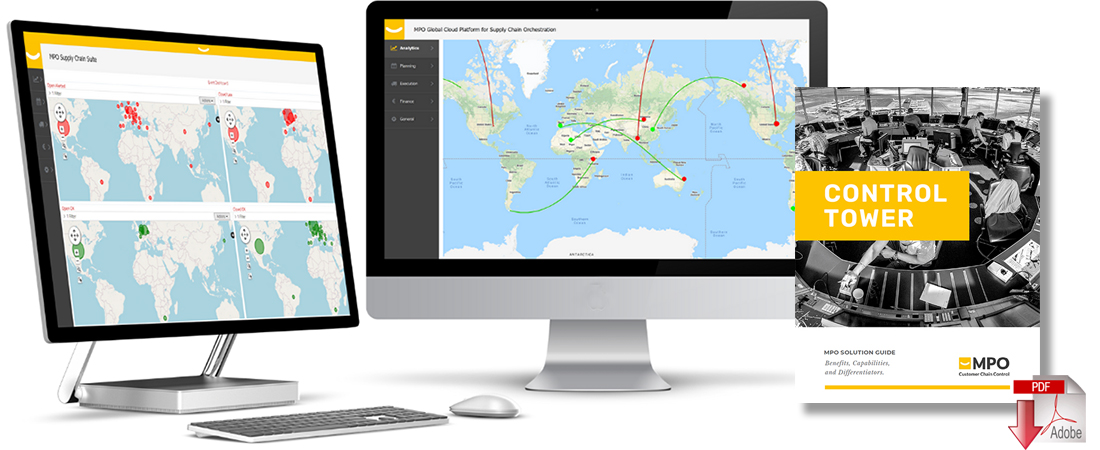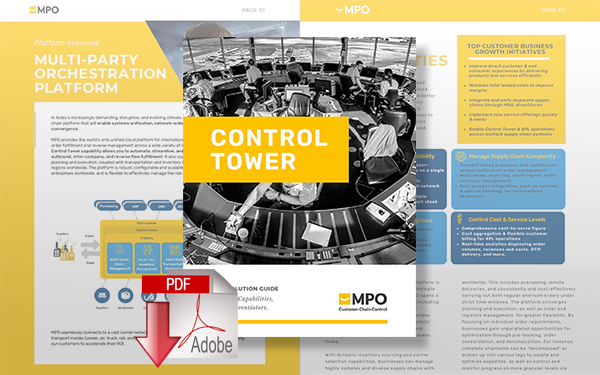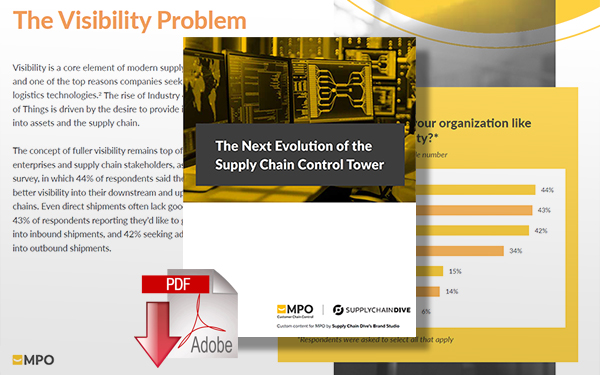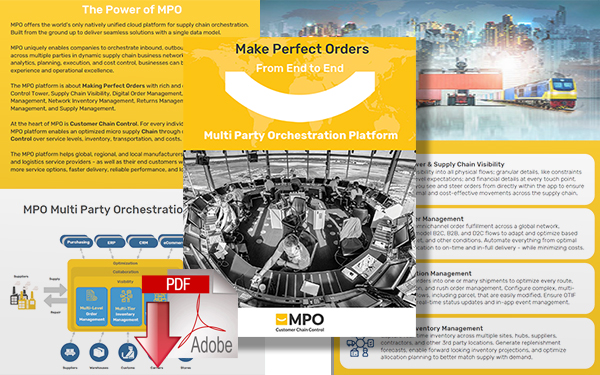What’s Preventing Visibility in Multi-Tier Supply Chains?

With so many companies feeling the urgency to build resilience and better manage risk, with all the growing pressure to operate sustainability and with greater transparency on how and where products are manufactured and sourced, and with today’s ease and ubiquity for connectivity and information at one’s fingertips, what is preventing supply chain visibility?
Supply Chain Visibility
A recent Deloitte survey estimated only 15% of CPO’s have visibility beyond their tier one suppliers. I found this striking.
With so many companies feeling the urgency to build resilience and better manage risk, with all the growing pressure to operate sustainability and with greater transparency on how and where products are manufactured and sourced, and with today’s ease and ubiquity for connectivity and information at one’s fingertips, what is preventing supply chain visibility?
Martin Verwijmeren, CEO of MPO, at the inNOWvate Supply Chain Event 2022 (watch the video to the right), stated:
“At the most mature stage, you have visibility into what is going on with your supply chain partners too. You share forecasts with each other and are able to predict exactly what will happen in the chain and when. To achieve that, you need artificial intelligence-based decision-making systems.”
The Same Underlying Issues Have Been Holding Companies Back for Years
Years ago, I was the CEO of a key supplier to a leading hardware appliance OEM (original equipment manufacturer). The manufacturer undertook a big initiative to get all their major suppliers on a hub with the goal of achieving full visibility over supply and demand, faster response to planning changes, and more effective collaboration with supply chain partners.
Although promising in theory, none of us wanted to share our performance data; we each saw the other suppliers as competitors and feared the visibility could disadvantage us in the marketplace. The manufacturer was a significant customer, so we capitulated, but the initiative was inadvertently cut short by market events. Nevertheless, looking back now, I can appreciate it as advanced for its time, and as the type of solution, we‘re all clamoring for today.
Even though supply chain visibility is far more achievable now, we’re still held back by the same underlying issues we had then.
Hesitancy Around Trust
Visibility comes at a cost – one we’ve spoken about before: trust. Some supply chains are trying to overcome this using blockchain, whose core function is to verify trustworthiness and reliability. Blockchain still poses numerous issues around entry and ownership within the growing and dynamic network environment, but chain-of-custody traceability is a must for visibility. That means looking beyond the materials provided by a company’s Tier 1 suppliers and the first line of customers who purchase their goods.
The broader value chain includes every supplier’s supplier and every customer’s customer. Successful traceability efforts require collaboration. No company, no matter how large, can collect all the relevant information needed for robust traceability. Partnering strengthens the competitive advantage of individual companies as well as the ecosystem.
Siloed Decision Making
Another typical holdback is that many companies still believe supply chain visibility is operations and procurement function and relegate it to that silo to manage. I’ve learned over the past few years that the presence or lack of visibility has company-wide implications and cuts across and impacts all functions. High-level steering is required to not only encourage but insist on cross-functional communication and decision-making. No longer can a company expect results from an up-over-down approach to decision-making.
Deciding When to Pull the Trigger
Companies make more dramatic gains or losses during downturns than stable periods according to Bain & Company. With the looming recession, they suggest avoiding the typical three traps: burn-the-furniture, spray-and-pray, or wait too long before acting. The reality is a purely reactive approach is the wrong answer. This is the time to decide if you’re better suited to play defense by paring back on non-core products and services, focusing on core strengths, or to play offense by pushing the envelope on growth.
The MPO Supply Chain Control Tower for Multi-Party Orchestration provides businesses across diverse industries with end-to-end visibility so they can act in real-time. By connecting people, systems, and processes network-wide on a single-view platform, shippers and logistics service providers drive visibility, collaboration, and optimization across both planning and execution.
Why It’s Worth Pushing Past the Discomfort
We’ve all been in situations where we felt uneasy or uncertain of an outcome. Begin by expanding multi-tier visibility with those in your ecosystem you trust. Open and willing supply chain partners allow you to test the value of data exchanges, helping to better [Business success] understand planning impacts, trace orders and shipments from allocation to delivery, and improve supply continuity, on-time shipments, and responsiveness to changes in supply and/or demand. Multi-tier upstream and downstream visibility will also enable you to dramatically reduce buffers and safety stocks.
Supply chain ecosystems that overcome initial concerns will likely do so to great advantage and these results can be shared with more hesitant partners. Common benefits include:
- Better asset utilization
- Reduced overhead from fewer expedites
- Lower cost of doing business with clients
- Ability to easily scale with partners
- Improved customer satisfaction
- The factual basis for performance management
Depending on your current digital maturity, company size, and complexity of operations, it’s not uncommon to see a remarkable return on investment (ROI). Founder and CEO of Alkimius Group: “The Innovation and Transformation Platform,” Mauro Gonzalez, shared with a Nucleus Research analyst that in his experience, businesses can save 3-7% in operational costs, as well as 3-5% in efficiencies across inventory, warehousing, distribution, and other parts of the supply chain just from implementing digital control tower and supply chain visibility technology. Moreover, neutral, cloud-based supply chain technology with support for real-time integration can typically help partners scale as fast as 2-4-month increments – sometimes even weeks.
“Businesses can save 3-7% in operational costs, as well as 3-5% in efficiencies across inventory, warehousing, distribution, and other parts of the supply chain just from implementing digital control tower and supply chain visibility technology.”
Organizations would do well to make the initiative cross-functional. Reimagining one’s entire business model and technology strategy aren’t easy, but it guarantees long-lasting, meaningful results. Think about it: The market and supply chain has evolved significantly over the past few decades, let alone the past couple of years, yet most systems of management haven’t changed that radically. Many organizations are trying to juggle unprecedented pressures – from supply chain shortages to sourcing challenges to the rising costs of raw materials and logistics – using spreadsheets, legacy systems, and siloed processes and technologies.
Given the magnitude of change and demand, companies simply can’t apply the same purchasing models and strategies they used to. Supply chain visibility can no longer be seen as a pure operations function; the impacts of visibility affect the whole company. Create cross-functional teams to bring wide-ranging perspectives to the table. Learn how the lack of visibility affects all areas of your business, from customer satisfaction to compliance with contracts. Doing so will build a fuller picture of the objectives, standards, and key results you should be striving for. It will provide operations with a well-rounded understanding of the breadth and scope of visibility solutions they need in terms of how success should be measured.
In today’s volatile market, it’s critical for businesses and their networks to push past their hesitancy around implementing multi-tier, multi-enterprise visibility and realize the benefits far outweigh the consequences. Implementing supply chain visibility helps create efficiency, reduce costs, and better serve customers. It is foundational to any sustainability initiative and integral to continued digital growth and transformation. But supply chain visibility alone is not enough. What will you do with what is revealed to you? In my next post, I’ll discuss how businesses can act strategically on what they see.
Ready to create transformative change? The MPO Multi-Party Orchestration platform provides diverse businesses the critical foundation of multi-tier, multi-enterprise visibility they need to mitigate risk and impact, control cost, and maintain operational excellence and high customer service levels under changing conditions. To learn more, contact our team at [email protected] or by requesting a demo today.
About the Author
Bryce Boothby is an MPO board advisor and former executive of Flextronics, Celestica, ModusLink, Regenersis PLC, and Lulu.com.
Related 'Control Tower' Resources
Key Differentiators: The Control Tower for Supply Chain Orchestration
This whitepaper offers insight into what makes a holistic platform unique, and how expanding visibility and control to span order and logistics management across all order types and all order flows provides extraordinary business value. Download Now!
Supply Chain Control Tower & Visibility
This Supply Chain Control Tower and Visibility solution guide provide a deeper look into the platform's capabilities and benefits, as well as a practical overview of why a unified and converged approach will make all the difference in running an efficient and cost-effective supply chain that drives superior customer satisfaction. Download Now!
The Next Evolution of the Supply Chain Control Tower
This white paper explores why visibility is a core element of modern supply chain digitization, and a top reason to implement logistics technologies in your supply chain. Download Now!
Multi-Party Orchestration Platform
In this brochure, you'll find a guide to MPO's unified cloud platform for multi-party orchestration, including its rich and flexible solutions: Control Tower, Supply Chain Visibility, Digital Order Management, Transportation Management, Network Inventory Management, Returns Management, Spare Parts Management, and Supply Management. Download Now!
More Resources from MPO
Related Article: Why a Lack of Supply Chain Visibility is Costing Your Business
Article Topics
MPO News & Resources
TMS+ Go Beyond Transport to Optimize Cost, Service, & Resiliency Multi-Party Orchestration Platform When It Comes to Digital Transformation You May Not Be Doing What You Think How Chief Operating Officers are Achieving Results with Supply Chain Software SPARK Matrix Transportation Management System Software Analyst Report Top Trends Driving Change and Technology Strategy Within Logistics & Transportation Management 5 Key Steps for Optimizing your Last Mile Delivery More MPOLatest in Supply Chain
U.S. Manufacturing is Growing but Employment Not Keeping Pace The Two Most Important Factors in Last-Mile Delivery Most Companies Unprepared For Supply Chain Emergency Microsoft Unveils New AI Innovations For Warehouses Let’s Spend Five Minutes Talking About ... Malaysia Baltimore Bridge Collapse: Impact on Freight Navigating TIm Cook Says Apple Plans to Increase Investments in Vietnam More Supply Chain



















